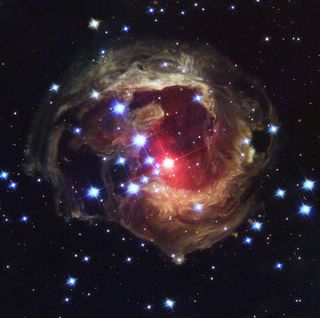
The Hubble space telescope strikes again. It's latest image, released Thursday, is a beautiful shot of swirling clouds of interstellar dust illuminated by the light from an exploding star.
Astronomers first detected the exploding red supergiant star back in 2002 and, since then, have captured a series of dramatic images as the light pulse explosion expands at a speed of 186,000 miles per second.Another image consists of six smaller images of the same star dating back to May 2002. For something extra cool, go to this link at HubbleSite where you can get a video of those six images blending from one into the next.
The exploding star is known as V838 Mon and is some 20,000 light years away from the Earth in the direction of the constellation Monoceros, on the very edge of the Milky Way.
During its 15 years, Hubble has offered convincing proof of black holes, provided insight into huge explosions of energy known as gamma ray bursts, captured images of the earliest galaxies that formed after the Big Bang and measured the speed at which the universe is expanding.And raised some interesting questions. Here's one, one of those things that you don't realize until someone points out what should have been obvious. I just came across it in this, from Space.com for April 2, 2003, and I admit the thought hadn't occurred to me before now:
Clarity is what astronomers and the public have come to expect from the Hubble Space Telescope. But the sharpness with which Hubble photographs distant galaxies has scientists pondering why the pictures are not blurry, as some new calculations suggest they should be, and whether some basic assumptions about space, time and gravity might have to be rethought.Simply put, the best current scientific hypothesis about the root structure of spacetime is that it's a sort of seething foam, with bits constantly popping into and out of existence. Light traveling through that foam should be slightly disturbed and the further it travels, the more the disturbance should add up. As a result, the galaxies shown in pictures such as the Hubble Ultra Deep Field should be slightly "fuzzy" beyond that of the unavoidable imperfections of the equipment. But they're not.
Hubble pictures are crisp and clear, no matter the distance to the object.And that could require a major rethink.
And that, say two separate teams of researchers, might mean there are flaws in quantum theory.
I've long had the suspicion that quantum physics is not the end. It just feels, I don't know, wrong somehow in a way I can't pinpoint. And I don't mean any of the so-called "quantum weirdness" (like particles being in two places at once) with which physicists love to torment non-scientists. I don't mean it defies common sense. Or, rather, it does defy common sense but since common sense deals with things on a human scale and quantum physics deals with things on a subatomic scale, there's no reason it should follow common sense. No, it's something else, just a sense for which I have no firm foundation. I guess what really got me going was one time talking with a physicist about how the issue of the arrow of time relates to quantum theory and at one point he would up telling me that an infinite amount of something could be equated with its nonexistence. That struck me as an example of what I call "hand-waving," getting rid of a problem by just waving it off as irrelevant or unimportant. (Note to science buffs: This was not a matter of renormalization.)
Let me be clear: I am not saying quantum physics is "wrong" or that I "don't believe it." No theory that has successfully and repeatedly predicted the outcome of experiments to over 30 decimal places can be called wrong. In fact, quantum and relativity physics (the latter of which also defies common sense) are the most spectacularly successful scientific theories ever.
What I'm saying is that just like Newton's laws of motion and of gravitation (which are still sufficiently accurate to land spacecraft on a moon of Saturn, among other things) were an approximation of reality more closely approached by Einstein's theory of special relativity, which in turn proved to be part of his deeper theory of general relativity, and which in its turn (to Einstein's chagrin) became one of the things that helped develop quantum physics, I have a suspicion that ultimately quantum physics - even after (or perhaps as part of) finding the Holy Grail of physics, a unification of quantum and relativity - will yield to something even deeper, even more profound, even more fascinating - and even further from common sense.





No comments:
Post a Comment